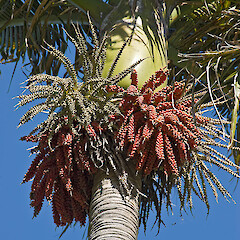Rhopalostylis sapida
Common name
nīkau
Synonyms
None
Family
Arecaceae
Flora category
Vascular – Native
Endemic taxon
Yes
Endemic genus
No
Endemic family
No
Structural class
Trees & Shrubs - Monocotyledons
NVS code
The National Vegetation Survey (NVS) Databank is a physical archive and electronic databank containing records of over 94,000 vegetation survey plots - including data from over 19,000 permanent plots. NVS maintains a standard set of species code abbreviations that correspond to standard scientific plant names from the Ngä Tipu o Aotearoa - New Zealand Plants database.
RHOSAP
Chromosome number
2n = 32
Current conservation status
The conservation status of all known New Zealand vascular plant taxa at the rank of species and below were reassessed in 2017 using the New Zealand Threat Classification System (NZTCS) – more information about this can be found on the NZTCS website. This report includes a statistical summary and brief notes on changes since 2012 and replaces all previous NZTCS lists for vascular plants.
Please note, threat classifications are often suggested by authors when publications fall between NZTCS assessment periods – an interim threat classification status has not been assessed by the NZTCS panel.
- Conservation status of New Zealand indigenous vascular plants, 2017 . 2018. Peter J. de Lange, Jeremy R. Rolfe, John W. Barkla, Shannel P. Courtney, Paul D. Champion, Leon R. Perrie, Sarah M. Beadel, Kerry A. Ford, Ilse Breitwieser, Ines Schönberger, Rowan Hindmarsh-Walls, Peter B. Heenan and Kate Ladley. Department of Conservation. Source: NZTCS and licensed by DOC for reuse under the Creative Commons Attribution 4.0 International licence.
2017 | Not Threatened
Previous conservation statuses
2012 | Not Threatened
2009 | Not Threatened
2004 | Not Threatened
Brief description
Palm to 15m tall with a ringed trunk and 3 m long erect leaves inhabiting lowland forest south to Okarito and Banks Peninsula and the Chatham Islands. Leaves with multiple narrow leaflets to 1 m long closely-spaced along central stem. Flowers pinkish, in multiple spikes at the top of trunk. Fruit red.
Distribution
Endemic. North Island, South Island from Marlborough Sounds and Nelson south to Okarito in the west and Banks Peninsula in the east. Also on Chatham and Pitt Islands. However Chatham Islands plants have a distinct juvenile form, larger fruits, and thicker indumentum on the fronds.
Habitat
Primarily a species of coastal to lowland forest in the warmer parts of New Zealand.
Wetland plant indicator status rating
Information derived from the revised national wetland plant list prepared to assist councils in delineating and monitoring wetlands (Clarkson et al., 2021 Manaaki Whenua – Landcare Research Contract Report LC3975 for Hawke’s Bay Regional Council). The national plant list categorises plants by the extent to which they are found in wetlands and not ‘drylands’. The indicator status ratings are OBL (obligate wetland), FACW (facultative wetland), FAC (facultative), FACU (facultative upland), and UPL (obligate upland). If you have suggestions for the Wetland Indicator Status Rating, please contact: [Enable JavaScript to view protected content]
FACU: Facultative Upland
Occasionally is a hydrophyte but usually occurs in uplands (non-wetlands).
Detailed description
Trunk up to 15 m, stout, covered in grey-green leaf scars, otherwise green. Crownshaft 0.6–(1) m long, dark green, smooth, bulging. Fronds up to 3 m long; leaflets to 1 m, closely set (sometimes overlapping), ascending. Spathes c. 300 × 150 mm, between pink and yellow, caducous. Inflorescence shortly stalked, with many branches, 200–400 mm long. Flowers sessile, unisexual, tightly packed, lilac to pink; males in pairs, caducous, stamens 6; females solitary, with minute staminodes, ovary 1-locular, stigmas terminal, recurved, persistent. Fruit c. 10 × 7 mm, elliptic-oblong, flesh red.
Similar taxa
Rhopalostylis baueri (Seem.) H.Wendl. et Drude, which differs mainly by its globose to oval fruits, and from most populations of R. sapida, by the broader leaflets. Both species of Rhopalostylis are very similar and research is needed.
Flowering
November–April
Flower colours
Red/Pink
Fruiting
February–November
Propagation technique
Easy from seed. Fruit should be soaked for a few days in water and then lightly scrubbed to clear the flesh, then place in sealed plastic bags in half shade until seed begins to germinate. Plant germinating seed in deep, narrow pots. Avoid disturbing the roots as much as possible. An excellent pot plant, and provided the tap root is left intact it can be easily transplanted. Quite hardy. Very variable in the wild, so could benefit from critical horticultural selection.
Etymology
rhopalostylis: Club style
sapida: Savoury
Where To Buy
Commonly sold by most retail plant nurseries.
Taxonomic Notes
The palm on the Chatham Islands is probably distinct from Rhopalostylis sapida but further research is required.
Attribution
Fact sheet prepared by P.J. de Lange for NZPCN (1 June 2013)
References and further reading
Esler AE. 1969. Leaf fall and flowering of nikau. Wellington Botanical Society Bulletin 36: 19–22.
Greenwood RM. 1969. Notes on growth of young nikau plants. Wellington Botanical Society Bulletin 36: 22–23.
NZPCN Fact Sheet citation
Please cite as: de Lange, P.J. (Year at time of access): Rhopalostylis sapida Fact Sheet (content continuously updated). New Zealand Plant Conservation Network. https://www.nzpcn.org.nz/flora/species/rhopalostylis-sapida/ (Date website was queried)



































